In Designing Audio Equipment
About artificial sound & musical tone
In the design of electronic devices, we often use the latest technology as much as possible to achieve the required functionality and performance. However, the design of audio equipments differs in some way from the approach of electronic devices. In the case of audio equipment, the emphasis is on the freshness of the sound rather than the complexity and functionality of the technology. More important for audio equipment are lively natural sound spaces as close as possible to live performances, without subtle electric and unpleasant side sounds, less coloration and exaggeration, capable of reproducing subtle “musical tone” and dynamics. It must be for this reason, in the design of audio equipment, we often leave the position of electronic equipment and need the same five (or seven) senses as making an instrument. In the case of an instrument, it always produces an ideal image for its musical tone, and it is finished as a work by removing noise and unpleasant sounds.
Certainly, many of today’s audio products may pursue “sound”, but they do not embody “musical tone” in them. That alone is an artificial playback device, and someday listeners get bored with listening. The acoustically and musically sought after audio not only uses the electric vibration and the mere physical “sound” but also evokes strong feelings that the listeners have over the medium, and the musician that the composer and performer wants to convey. It can make you feel the lingering sounds that appear and disappear in the blink of an eye. It can heal the heart, sometimes even a message that sticks in the heart.
Power to wake music
Audio equipment requires only one thing to serve as a medium for listening to music. It is not to lose the ability to “call up music” to the world of human inner consciousness. Detracting, falsifying, twisting or exaggerating the musical thing deviates from its role. To that end, the audio equipment should be as simple as possible and a fresh air that creates a sound space. Because there is no device or parts with perfect performance, the more complex it becomes, the more it will be repeated as many times as copying will become blurry and unreliable. So, the most important technology for audio equipment is to keep the music fresh and deliver it to the listener in a minimal way, that is all. As far as audio equipment is concerned, there is a good reason to move towards minimalism. No matter how good the technology, you can not recover the once-lost musical tone. From a musical standpoint, I think we should always be cautious about introducing complex technology with the risk of side effects.
Technical Topics
Complete in house development & handmade
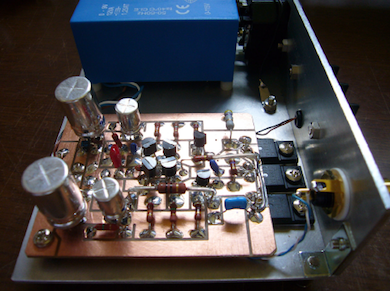
Our products are handmade in-house in all hardware (except chassis) and software, and we do not consign external design, development and manufacture on an outsourced basis. We know the details of the products we handle and then commercialize it, always aim to create products that make use of the latest technology and experience, and strive for daily improvement. We make a line from the horrible economic system of efficient market supply and recovery of profit by mass production, and try to carefully finish each one as a “work” by careful production unique to handmade.
Ultra-low jitter reclock oscillator
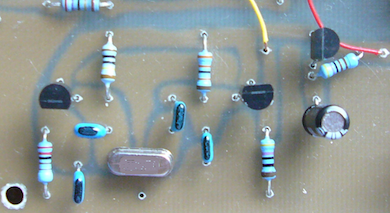
Sparkler Audio has one clear view of transforming digital audio. Recently, a new format of high bit, high sampling digital audio so called “high resolution” is becoming popular, but we can not deny that in itself. However, 16-bit audio data such as CD format should not be processed by up-sampling etc., and it should be converted to analog with 16-bits as it is called non-oversampling.
There is a solid basis for this claim. High sampling always requires a very high clock frequency, such as 256 times, which increases the jitter (temporal fluctuations of the clock signal) and is the source of creating a de-focused, unsharp sound. As you might expect, the clock signal is analog itself in our real world. When the clock changes, the pitch of the sound changes as it is. As a result, the oversampled sound will have unclear scales and harmony of chords will be lost. In addition, jitter is also increased by the peculiarities of the transport itself and the noise of the transmission path. The solution is a fully discrete clock oscillator with very low noise transistors. By reclocking the digital signal by this, the original performance of digital audio is exhibited. Our digital audio products fully adopt their ultra-low jitter clock oscillators.
Non-oversampling is still a good freshness!

Nothing in addition, do not catch anything, no digital filter non-oversampling is still a good freshness. There is no rise in blurring or bleeding at all of the sound. On the other hand, non-oversampling DAC requires a cleaner power supply. By replacing standard IC power regulator to discrete circuit, more clean (about -20dB, 1/10) the power supply, also accurately reproduce fine sound. The power supplied to the built-in DAC, you can switch the internal power supply and the external power supply. As a result, by an external battery-operated, you will enjoy in a more quiet sound quality.
16-bit, reconsideration and new approach ― Development history of “D/A processor engine”
The reason why digital audio became popular was the CD (compact disc) that appeared in 1982. Since then, the digitalization of music media has progressed remarkably and has been further supported by the spread of computer technology and the Internet. On the other hand, analog discs such as LP records have been declining temporarily due to the wave of digitalization, but in recent years, not only audiophiles but also many people have come to review again. That’s because there is a world of elaborate and rich sound that can only be enjoyed with analog records, and we also feel that there is something missing in digital audio. So what is the missing part?
When the CD was born, of course, there was no “high-resolution” music distribution as it is today, and it was thought that 16-bit sound could surpass the quality of analog records. Surely, CDs are easier to handle, reduced noise, and the track can be selected with remote control. Once the CD was recognized as a standard format suitable for music media, its playback devices also spread dramatically on the market, and along with that, it became possible to listen to numerous types of music on the CD. It is certain that there are points beyond the vinyl disc in this way, but it cannot be denied that there are some points that are not so in the sense of hearing.
Then, it is not so easy to say that it will be better if it is digitized more finely. The aim of so-called “high-resolution” is to transmit analog signals more finely and with higher precision digitizing. It can be acceptable because it is inevitably associated with the development of digital technology. But then, no matter where we go, we won’t leave the field of digitization. Many new formats that exceed the performance of CDs are defined one after another, and the advantages of each are being promoted, but there is still no overwhelming market to replace CDs. Because it is annoying to have a variety of formats for ordinary listeners, and it’s enough because we can usually enjoy music on CDs already on the market. Also, the CD in a beautiful jacket has a presence rather than just the data on the computer, and we want to keep it like a favourite book.
Our main focus is on the lack of usefulness of CDs. There is a feeling that we also want to try high-resolution, but it is a shame that we don’t have time to change and handle it halfway. So we decided to do our best with the CD for a while. However, if we listen to the music carefully, the sound quality of the CD is still very impressive, and we respect the excellent achievement of the basic research of the predecessors. Certainly, 16-bit performance is too good for the human ear, and there is no doubt that there are more possibilities if it can be played properly.
We will approach the main topic from now on, but one thing we are interested in recently is that compared to analog records, the sound quality of a CD is that the harmonic content is not clear. In other words, the sound does not “stand” like a live musical instrument, and there is a feeling of “sleepy” that is peculiar to digital. It is not a lucid sound. Interestingly, it is not limited to CDs, and we get a similar impression when we listen to a high-resolution sound source. Perhaps it was missing or altered by digitization itself. On the other hand, the playback of analog records is more like the way a musical instrument sounds because there is a process of physically rubbing a groove.
To explain such an impression in technical terms, it means that “the higher the frequency, the more unclear the phase”. The phase represents a position on the time axis of a periodically changing wave. If the phase of the harmonic component is significantly shifted, the timbre will be different, so there will be no instrument-specific sound. If the phase is disturbed, the chords is not played in harmony, the focusing of the sound image is ambiguous, and the parts of the instrument that contain their specific overtones cannot be determined. Moreover, the loss or alteration has already occurred when the analog signal is converted into a digital signal, and even if the reproduction device restores the digital signal to analog faithfully, the phase once shifted is not restored. The sound quality is so smooth and transparent that it is aimed at faithful reproduction such as oversampling method, but it alone is boring. For example, the tension of a piano string that vibrates with a strong keystroke, or the sparkling overtone in the prompt sound, will not come out even if the digital signal is reproduced faithfully. The high range is delayed by one tempo no matter how many times we listen. But we aim to reproduce it. The vibration of a piano string actually contains over 7th harmonic components (more than 3 octave overtone), which determine the unique sound of the piano. When playing back musical tone, we feel that it is very important to be able to hear the pitch clearly.
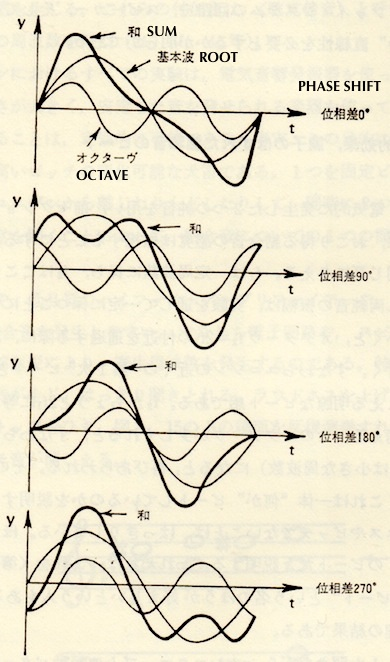
the waveform changes every moment and can be heard as a beat.
The foot of the lighthouse was really dark. That is probably because the original digital signal itself is already out of phase. As a result of forcibly rounding the position on the time axis at the sampling frequency of 44.1 kHz, the phase is not correctly recorded, and the phase may already be shifted from the original analog signal. They are also called “phase distortion”, which means that they are not in line. We won’t go into detail because it goes into the difficult sampling theory, but we think that you can understand the audibility from experience. In an extreme example, it looks like white noise when not receiving FM broadcasts, and the sound image is not focused anywhere. The natural space where musical tone resonate is on the other side. CDs that are not good at recording or digitizing will not produce a decent sound no matter how the original sound is played, but the key to solving it should be elsewhere. Therefore, after the digital signal is converted to an analog signal by a device called a digital to analog converter (DAC), it is necessary to correct this shifted phase in the entire audio system. There is not much problem with a modern amplifier with a simple characteristic, but with a classic amplifier with a narrow band, the phase is gradually delayed in the high frequency range, and even in the ultra high frequency range, oscillation may occur. In comparison, loudspeakers are not very accurate in phase and have a strong character. Cables that are often overlooked are also spiders. When listening in total, the phase is still out of phase. Jitter is also a temporal fluctuation of a digital signal like an arrhythmia, so it also affects the sound quality. Apparently the human sense seems to be particularly sensitive to time fluctuations.
Furthermore, it is also necessary to electrically compensate for the super-high frequency overtone component that has been lost due to the digitization of a limited band, as occurs in an actual musical instrument. Many of them will not be heard by human ears, but they feel as if the instrument is sounding there, and the tension and atmosphere of the air. It becomes even more difficult to reproduce the sound field and the sound of the hall. However, this can be improved by correcting the phase shift, and the sound reverberates beyond the presence of the loudspeakers. However, if we make a big deal like multi-channel surround, we can’t use the existing audio system as it is. Can we manage it in the range of two channel stereo? This is because it is the most desirable and practical way to make it closer to a realistic acoustic space by simply modifying a part of the existing system.
Up to this point, we haven’t gone out of speculation and contemplation, so we decided to prototype a DAC with such phase correction. Non-oversampling (NOS), which does not process digital signals, is rather convenient for experiments because the phase characteristics remain as they are. After converting to an analog signal with a standard 16-bit NOS-DAC, we first passed a filter that gradually advanced the phase in proportion to the frequency in the audible band where the human ear is sensitive. Next, in order to generate a missing harmonic component, a circuit that emulates a triode vacuum tube with a relatively high harmonic distortion was assembled with a semiconductor. As a result of repeating the audition with various parameters changed, it became a very realistic and pleasant sound with a certain correction value. It was unnatural if it was overcorrected, but it doesn’t have to be as strict as pinpointing. The older recordings is more effective, so the old equipment was probably out of phase. If the correction is appropriate, the delicate passages that have been buried will come out. It doesn’t hear like a CD, but rather close to the sound of a fine analog record. The sound quality is crisp and it is almost like a record needle physically rubbing a groove. In addition, the space expression of the performance venue becomes more natural, and we can feel the sound of being wrapped anywhere in the room despite the two channels. A person happened to hear this prototype and was wondering where it was sounding. Of course, when I answered that they were from these two speakers, he couldn’t hear that way, and looked around mysteriously that there were other speakers somewhere. We are working hard to further refine this prototype and commercialize it as a 16-bit DAC with a new approach. <10 October, 2019>
Noise Protection
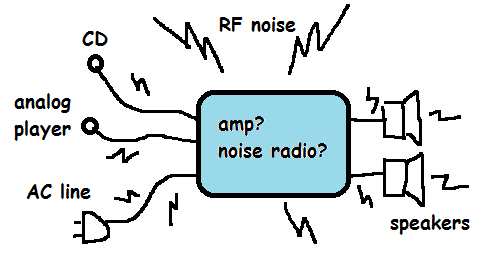
We, audio listeners live in an increasingly crowded technological environment. As our lives become filled with technology, every lamp (LED, fluorescent, etc.), cell phone, computer or other technical gear contributes to the electrical noise around us. Also there are many kind and wide bandwidth noise source around audio instruments. However, interconnect cables and chassis is one of effective RF (radio frequency) antenna! Then the audio circuit also becomes “noise radio”, because these RF noise raise inter-modulation distortion and make sound signal dirty. If there is no noise, the audio circuit will work more completely (ideal). So we have studied how to reduce noise from external environment, common impedance and internal RF pulsive devices. On this viewpoint, we develop our products.
Dealing emphasis CD
There is old CD, that has been emphasis processing (high-frequency enhancement) as analog records, some of them are on the market today. Playback of such emphasis CD is still, is where you want to listen to return the correct flat response to the original. In S503/S507 of the built-in DAC, automatically recognizes the track that has been pre-emphasis processing, and de-emphasis it by analog filter.
All Stainless Steel ― Good quality music dwells in a sturdy structure

Including the chassis, spacers, bolts and nuts, all have adopted the stainless steel. Among the metal, stainless steel rigid vibration transmission speed (about 5740m / sec.) is comparatively faster. Not accumulate the vibrational energy to the chassis, the mechanical ground of the vibration that quickly performed, was to further improve the expressive power of a fine sound. In addition, the electrical resistance (internal loss) of stainless steel is larger than that of the copper and aluminum (about 429 times that of copper), to absorb the electromagnetic noise from the internal circuit and external environment, there is also the advantage of easily consumed as heat. In this way, we are contributing significantly to the low noise of the material of the chassis.
Voltage-mode and Current-mode signaling
Voltage-mode signaling is to transmit a signal by changing the voltage and receive it by high impedance voltage load (10..100kΩ), which is used in conventional audio equipments. On the other hand, current-mode signaling is to transmit a signal by changing the current and receive it by very low impedance current load directly (0Ω), which has many benefit for low noise, pure and long distance transmission. The external induction always raises voltage-mode noise, so it can be protected only by current-mode signaling. As a result, the sound has pure, musical, high resolution and vivid quality. The last letter “i” of our model number indicates this current-mode signaling.
A new approach to audio system design ― Current-mode signaling
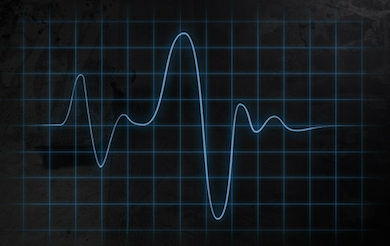
Contemporary audio component design relies heavily upon complex component and microprocessor technology to obtain broad multi-functional capabilities. These, often complex designs derive however from the fundamental physics of digital and analog signal processing and years of refinement in design of circuits to preserve the integrity of audio content in dac and adc conversions. In addition, handling analog and digital signals, the process of converting them to each other is based on many years of research results of transmission and communication technology and information engineering. This document examines our most fundamental assumptions regarding digital/analog signal conversation and the possibility of creating a more efficient and loss free technology obtaining a new level of excellence in signal quality. In the design of high precision communication and test instruments more precise signal integrity has been obtained by employ modulated “current” rather than modulated “voltage”. This same current-mode signaling (alias current transmission, current modulation, current-mode interconnection) approach has recently been applied in audio system design to obtain remarkable results in signal quality and efficiency. Compared with traditional “voltage-mode” technology, “current-mode” of an audio signal provides a wide spectrum of advantages deriving from the underlying principles of circuit design.
Analog Output Stage ― Available voltage-mode & current-mode signaling
As for the current-mode signaling type, the output stage amplifies the current from the DAC chip by current mirror (in principle no nonlinear distortion occurs), obtains the analog output current directly, and it has a completely new constitution, and it is characterized by sound quality with highly pure musical power. Once you listen to the sound quality of current-mode that has reached the area where you are awake, you will not forget. In the case of voltage-mode, since the current amplification is converted to a voltage-mode signal with one low resistor, the sending impedance is very low and your amplifier is firmly driven.